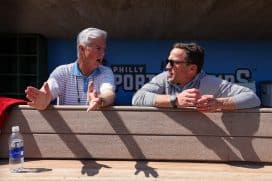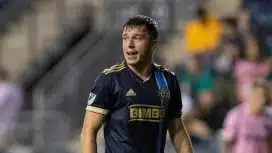Sixers
Poor Shooting Dooms 76ers in Close Game 3 Loss to Celtics
By Matt Gregan, Sports Talk Philly Editor
Poor shooting proved to be too much to overcome on Friday as the 76ers fell 102-94 to the Boston Celtics in Game 3 of the first-round series. Philadelphia battled throughout, playing with a lot of physicality, and held a two-point lead with 2:14 remaining, but Boston went on a timely 10-0 run to end the game and further deepen the hole the 76ers are in. The Celtics hold a 3-0 lead in the series.
The 76ers, who find themselves on the brink of the end of their season, have a chance to avoid elimination in Game 4, which is on Sunday at 1 p.m.
Here are some observations from the loss:
1. Despite the loss, the 76ers played with some character, grit and physicality
It might not be saying much, but the 76ers showed up and played with physicality and grit in Game 3. Just two days after a brutal blowout loss in Game 2, questions abounded about the 76ers lack of energy and whether or not they had the mental fortitude to bounce back in the series. Their play in Game 3 can best be described as scrappy and gritty.
However, playing with physicality and grit does not do much when you are unable to hit a shot from anywhere on the court. The 76ers shot just 29.5% from the field and 23.1% from 3-point range in Game 3, neither of which were good enough to power them past Boston despite the infusion of energy and better defense. The 76ers became the first team since May 11, 2017 to shoot below 30% in a playoff game, according to Jay King of The Athletic.
Joel Embiid finished with 30 points and 13 rebounds, and he made 14 of his 16 attempts from the free-throw line. The only reason the 76ers were in the game, despite their horrendous shooting, was their ability to get to the free-throw line. From the opening quarter, where Philadelphia got the line 15 times, the 76ers did a good job drawing contact and playing with physicality on offense. Philadelphia shot 29-of-34 from the free-throw line in the loss.
One area the 76ers decisively won in Game 3 was on the boards, mostly due to their hustle and physicality. Philadelphia out-rebounded Boston 57-45, including a massive 20-3 advantage in offensive rebounds. Tobias Harris stepped up in terms of aggressiveness and physicality in Game 3, finishing with 15 points and 15 rebounds. Harris played a major role on the offensive glass, finishing with eight offensive rebounds.
2. Fourth quarter struggles continue
For the second time in this series, the 76ers offense struggled mightily in the fourth quarter. The 76ers were outscored 34-22 in the fourth quarter of Game 1, and they were outscored 26-22 in the fourth quarter on Friday.
Boston, coached by Brad Stevens, is one of the best teams at making mid-game adjustments. Stevens and the Celtics have continually gotten ahead of the 76ers in this series based off some key adjustments. The 76ers are going to feed Embiid the ball, especially in the fourth quarter, so Boston makes the adjustments of throwing more double teams at Embiid. This forces Embiid to get rid of the ball, therefore taking it out of the hands of the 76ers' best scorer.
Embiid dominated in the first half of Game 3, scoring 22 points and grabbing 10 rebounds heading into halftime. However, he scored only eight points in the second half, which just is not good enough for your top scorer. The Celtics do a good job of throwing double teams and different looks at Embiid, so Brett Brown should make some adjustments to change things up for the 76ers late-game offense.
Part of the 76ers' late-game issues is that they lack a go-to shot creator, someone who you can give the ball to and feel confident they are going to get a good shot. While Josh Richardson has played well in this series, he is not nearly good enough of a shooter or ball handler to be that guy late in games. Tobias Harris, who still has not hit a 3 in this series, does not provide enough of a consistent outside shot to be a threat, and he also lacks the aggressiveness to be a go-to scorer in crunch time. Shake Milton attempted to fill some of the shot creator role in Game 3, but he does not possess the necessary ability to consistently hit shots in the paint and on drives to the basket.
The 76ers, come playoff time, will not be able to compete and match up well with opposing teams until they find someone who can fill the role of being a go-to shot creator and late-game scorer.
3. Defensive adjustments against the pick-and-roll
One area the Celtics were killing the 76ers in early in the series was pick-and-roll offense. Jayson Tatum, Jaylen Brown and Kemba Walker were feasting out of pick-and-rolls because the 76ers were giving them space by using a designed drop coverage. However, Brett Brown made some adjustments to successfully limit the dangerous Boston pick-and-roll.
The 76ers' wings played more aggressively around the screen and had their bigs move up closer to the pick-and-roll action to thwart the open 3 or mid-range shot. It proved successful in Game 3 as Jaylen Brown and Jayson Tatum found less open space to work with, and as a result were held to 21 and 15 points respectively. The one player on Boston who still managed to have a good game out of the pick-and-roll was Kemba Walker, who used his craftiness and speed to finish with 24 points.
Josh Richardson's defense on pick-and-rolls stood out in Game 3. He consistently ran around the screens and affected the shot, playing a big role in why Tatum and Brown both struggled. He finished with two steals and two blocks in the loss.












































